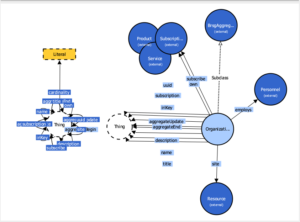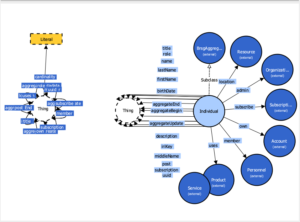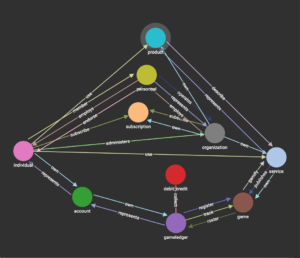
Agile Gamification Model
The purpose of this weblog post is to introduce a Temporal Linked Data® (TLD) data model by way of a generic gamification model. To visualize the model’s vertices (TLD Aggregates) and edges (TLD Links) we will use the Visual Notation for OWL Ontologies (VOWL) plugin within Protege. Each TLD Aggregate is comprised of OWL Datatype Properties (literal values represented by XSD base types) and OWL Object Properties (URIs that reference another TLD Aggregate, or other RDF Resource). Each TLD Aggregate keeps the current value for each property as well as all changes applied to the aggregate over time, making them temporal data structures.

A well bounded context. TLD links aggregates that comprise a solution, trusting that it can link to other solutions as required, along the way, rather than ahead of time. (Image credit: NOAA/NASA GOES Project)
Let us assume that this Agile Gamification capability is a hosted service provided by a third party Organization, such as BRSG. The idea would be that each team member would be an Individual known to the multi-tenant service provider. Further, “Agile Gamification” would be an instance of a Game made available through an Organization, such as BRSG, but owned by the Organization that has a Subscription for the Game. The Game is a BRSG Product made available as a Service at a public URI. Each Individual is invited to play the Game and does so through their Game Ledger which has a special journaling data type called a Debit-Credit that keeps a running tally of their score by receiving “debit” and “credit” events described in the Agile Gamification weblog post. Let’s look at these TLD aggregate models using VOWL.
The Organization depicted here is comprised of eight OWL Datatype Properties to identify, describe, name, associate, and track each organization instance. Likewise, Organization contains six OWL Object Properties that link it to its’ external site, personnel, subscription, products, and services. These RDF Properties, taken together, comprise the organization aggregate model.

Example “Organization” aggregate comprised of eight Datatype Properties, and six Object Properties. (Image credit: Protegy VOWL Plugin)
The Individual depicted here is comprised of 15 OWL Datatype Properties and seven OWL Object Properties that serve the same purpose as they do for Organization.

Example “Individual” aggregate comprised of 15 Datatype Properties, and seven Object Properties. (Image credit: Protegy VOWL Plugin)
Each individual TLD aggregate is modeled in this manner, both decoupled from each other while also cohesive in their overall structure and purpose. When taken together, this network of TLD aggregate models are represented by a graph and can be directly projected into a third-generation graph database such as TigerGraph or an RDF-oriented Knowledge Graph such as ReactiveCore. The following is a non-temporal representation of the TLD data model in TigerGraph (we will provide the temporal version of the TigerGraph schema when we get to the analytics posts).
The next post will discuss how gamification can augment operational data for clarity, validation, timeliness, and additional perspective.

